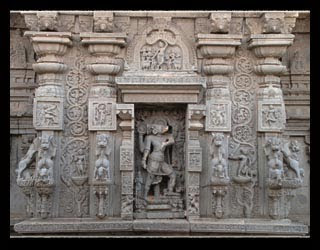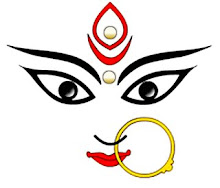SIMHACHALAM [the lion hill], which rises to about 800 feet about the sea, stands just north of Visakhapatnam. Near the top of the north side of it, in a wooded hollow surrounded by a wide circle of higher ground, is the temple to Narasimha, the man-lion incarnation of Vishnu, which gives the hill its name.
This is the most famous, richest, and best sculptured shrine in Visakhapatnam, and in its honour number or the people of the district are named Simhachalam, Simhadri, Narasimha and so on. From the hollow in which is stands, a deep glen, watered by a rivulet and clothed with many trees in striking contrast to the bare flanks of the rest of the hill, runs down to the foot of the northern slope, where, about ten miles be road from Visakhapatnam, is a rose-garden which is traditionally declared to have been planted by the well-known Sitarama Raju of Vijayanagaram and is watered from the rivulet.
The Rajas of Vijayanagaram have been wardens of the shrine for over two centuries and have endowed it with land of 11,000 acres for its maintainance. The way up to the temple runs along the glen from near the rose-garden, through terraced fields of pineapples dotted with mango, jack and other trees. It passes up a broad flight of wellkept stone steps, over a thousand in number, on either side of which trees have been planted to give shade and a rill runs in a stone channel to refresh weary pilgrims. At frequent intervals are images of the various. Hindu gods in little niches, and on festival days the steps are lighted from top to bottom, The steps eventually reach the narrow mount of the glen, and here the path is barred by a bold portal called Hanuman's gate, by the side of which the rivulet which passes down the glen is led in to two pools where pilgrims bathe before they continue the ascent. This gate was apparently part of the fortifications which on former days guarded the temple and other remains of which may be traced on the high ground surrounding it. Tradition says that these included as many as 24 bastions.Passing through Hanuman's gate, the pilgrim traverses a narrow part of the glen where the rivulet is led through pipes and channels over several artificial cascades surrounded by more sculptures of the gods, and at length reaches the amphitheater in which, on a terrace partly cut of the hill-side, stands the temple itself.
Sthala Puranam
The local Sthala purana contains a mythical account of the foundation of the building which relates the well-known story of how the demon Hiranya-Kasyapa,furious with his son Prahlada's devotion to his petaversion Vishnu, had the boy thrown into the sea and Simhachalam hill placed on top of him ; how Vishnu in his man-lion incarnation went to the youth's rescue, stood on one side of the hill and tipped it up so that the boy could crawl out on the other : and how Prahlada in his gratitude founded this shrine.
The exact age of the temple is not known, but it contains an inscription, dated as far back as 1098-99 A.D.,of the Chola king Kulottunga I who conquered the Kalinga territories, and it must thus have been a place of importance even then.
Another inscription shows that a queen of the Velanandu chief Gonka III (1137-56)covered the image with gold : a third says that the Eastern Ganga king Narasimha I built the central shrine,the mukhamandapam, the natyamandapam, and the enclosing verandah in black stone in 1267-68 : and the many other grants inscribed on its walls (the Government Epigraphist's lists for 1899 give no less than 125 of these) make it a regular repository of the history of the district.The Simhachalm temple still contains in inscriptions left here by Srikrishna Devaraya of Vijayanagara empire recounting his successes and relating how he and his queen presented the yod with necklace of 991 pearls and other costly gifts Architecturally the temple apparently deserves high praise. But this is said to contain a square shrine surmounted by a high tower, a portico in front with a smaller tower above it, a square sixteen pillared mandapam (called the mukhamandapam) facing this, and an enclosing verandah, all made of dark granite richly and delicately carved with conventional and floral ornament and scenes from the Vaishnavite puranas.These are doubtless the work of the Narasimha I referred to above. Much of the carving is mutilated (by Muhammadan conquerors, it is said). One of the pillars is called the kappam stambham or 'tribute pillar'. It is credited with great powers of curing cattle-disease and granting children, and in olden times the right to collect the numerous tributes paid to it in consequence is annually sold by auction. In the verandah is a stone car with stone wheels and prancing stone horses.
The image of the god is small and is kept covered with an unctuous preparation of sandal pasts. Once a year, in May, this is removed with much ceremony at the festival called Chandanayatra.Outside this inner enclosure there is little worthy of note except the excellent natyamandapam on the north side of the temple, where the god's marriage is performed and which is also to work of Narasimha I. This is supported by 96 pillars of black stone, arranged in sixteen rows of six each, which are more delicately carved than any others in the temple, are all different in the details of their design, and yet avoid incongruity of effect by adhering to one general type - especially in their capitals, which are usually of the inverted - lotus shape.
Legends
Hiranyakasipu was a Rakshasa king. He was in fact one of Vishnu's Dwarapalakas or gate keepers in Vaikuntha, Jaya and Vijaya. They had to take birth in the mortal world thrice because of a curse given by Sanaka, Sanandana, Sanathana and Sanathkumara, who were not allowed to take darshan of Mahavishnu by them. The other palaka was born as his brother Hiranyaaksha. Hiranyakasipu wanted to become immortal and hence performed austerities (tapasya) to propitiate Lord Brahma. However, Lord Brahma said that was not possible so Hiranyakasipu asked Lord Brahma to grant him a boon so that he could not be killed by any animal or a man neither in the morning nor in the night, by any weapons, neither in sky nor on the earth.
Hiranyakasipu wanted the entire world to worship him. But, Prahalada, his son, was a devotee of Lord Narayana and always expressed his bhakti towards Him. In spite of warning him several times, Hiranyakasipu could not alter Prahlada's devotion. This made Hiranyakasipu angry and he made numerous attempts to get Prahlada killed. One of them was to throw him off the top of a mountain. However, Vishnu rescued him by moving the mountain and made a small path for Prahaladha. It is said that in the place where the Lord stood to protect Prahaladha is the place where the temple is built.
KAPPASTAMBHAM
"KAPPASTAMBHAM" situated in the temple as token of their respect towards God for blessing their children and for their prosperity. There is another practice also in existence from time immemorial that some of the devotees will also observe pradakshanam along with the calf around the prakaram with faith as they get salvation. Most of the devotees coming from Orrissa State and North coastal districts of Andhra Pradesh are observing this practice during their pilgrimage.
This pillar was infused with only Godly and Miraculous powers. Since the devotes who aspire some desires to get fulfilled put forward offerings(Kappam) to this pillar, this pillar assumed the Name KAPPASTHAMBAM, At the bottom of this pillar Santhana Gopala Swamy image (Yanthram) was installed. So the devotees are of the belief that if the childless couples embraces this pillar, they will be blessed with children erelong. The devotes also believe that for whatever desires to get fulfilled they extend offering and hug this Kappasthambam all those desires will surely get fulfilled forthwith.
Poojas
TYPE OF POOJA TICKET COST
*Astothara satha naamaarchana Rs 100
*Sahasra Naamaarchana Rs 200
*Nithya kalyanam Rs 1000
*AmmaVaariki Astothara satha naamaarchana Rs 50
*Amma vaariki Sahasra Naamaarchana Rs 116
*swarna pushpaarchana (only on Thursday 7:00 A.M) Rs 1,116
*Laksha Tulasi Pooja Rs 1,116
*Laksha Kunkumaarchana Rs 1,116
*Garuda Seva Rs 200
*saaswatha Nithya kalyanam Rs 10,000
*Saaswatha Laksha Kunkumaarchana Rs 10,000
*Saasvatha laksha Tulasi Pooja Rs 10,000
*Saswatha Garuda Seva Rs 2,000
*saaswatha sahasra naamaarchana Rs 2,000
*saaswatha astothara sathanaamaarchana Rs 1,000
*Nitya pooja Bhoaga Kainkaryamu Rs 10,000
*Go Pooja Rs 50
*Kappa stambham alinganam Rs 25
TYPE OF DARSAN TICKET COST
*Pratyeka Darsan Rs 20
*Seeghra Darsan Rs 100
*Suprabhaatha seva Darsan Rs 100
*Suprabhaatha seva Darsan Rs 100
*Nithya Dhupa seva Rs 100
*Aaraadhana seva Rs 100
*Pavalimpu seva Rs 100
VEHICLE POOJA TICKET COST
*Lorry / Bus Rs 300
*Car /Jeep Rs 200
*Two Wheeler Rs 100
Uthsavams
Ugaadhi [TELUGU NEWYEAR]-Pandhiri paata utsavam,making SRI Swamy as bride groom.
"RADHOTSHAVAM" Also there before Swamy going to marriage.
KALYAANOTHSAVAM
SrI Swamy vaari Vaarsika THIRUKALYAANA MAHOTHSAVAM [From Chaitra sudda dasami to Chatra Pounami)(march/april]
NRUSIMHA JAYANTHI :
Will be Celebrated on these day SWAMY VARI JAYANTHYUSTHAVAM [Vrushabha Sukla Chathurdasi].The Narasimha Jayanti festival, which occurs on the Fourteenth day of the first half of month of 'Vaisakha' is celebrated as Birthday of the Lord.
[Vaisaakha sudda thadiya,Akhsara Thruthiya][april/may].It is the one of the holy days in temple festivals.
JYESTA POURNAMI:
"THRUTHIYA CHANDANA SAMARPANA" At early Mornimg.
GIRI PRADHAKSHINA :
It comes on "AASHADA POURNAMI" generally at june/july months.on this day the people walk around the simhachalam hill which was in distance 34 kms.
On the full moon day in the month of 'Ashadha', June, the devotees of the Lord, hailing mainly from the countryside, observe a fast on this day and go around the hill over a distance of about twenty miles. They eat their dinner after completing the Pradakshina and after having ' Darshan ' of the Lord. Those, who cannot undertake this, satisfy themselves by making 108 rounds in the temple itself.
CHANDANOTHSAVAM
It is also called "NIZAROOPA DARSANAM",Usually comes in the month of april/may.
On this day lot of people were try to have darsan of lord NARASIMHA from early morning.On this day the swamy gave darsan without chandana layer on his body called NIZAROOPA DARSANAM
Route Map
* Simhachalam is a hill temple that is almost 18 KM away from Vizag or Visakhapatnam.
* It is just 13 KM away from Vizag International AIRPORT.
* It is 19 KM away from Visakhapatnam Railway station.
* It is 20 KM away from R.T.C complex, Visakhapatnam.
[Bus no's:6,6A,6a/H,28 z/h,28s,28V,60]
Accomodation :
The Devasthanam of Simhachalam provides accommodation facilities for pilgrims. There are choultries, cottages and guesthouses with all facilities.































No comments:
Post a Comment